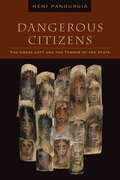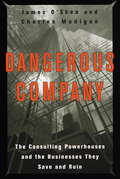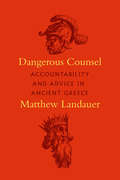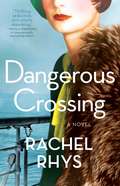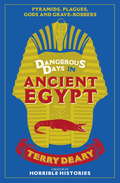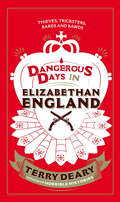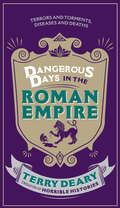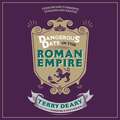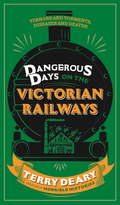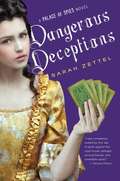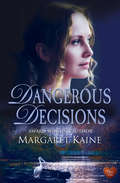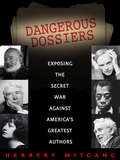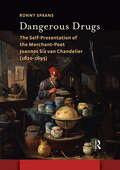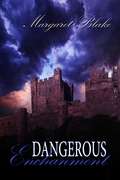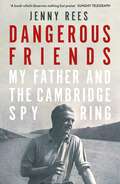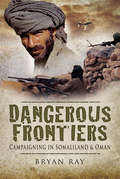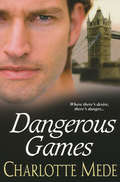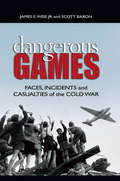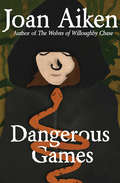- Table View
- List View
Dangerous Citizens: The Greek Left and the Terror of the State
by Neni PanourgiáThis book simultaneously tells a story—or rather, stories—and a history. The stories are those of Greek Leftists as paradigmatic figures of abjection, given that between 1929 and 1974 tens of thousands of Greek dissidents were detained and tortured in prisons, places of exile, and concentration camps. They were sometimes held for decades, in subhuman conditions of toil and deprivation.The history is that of how the Greek Left was constituted by the Greek state as a zone of danger. Legislation put in place in the early twentieth century postulated this zone. Once the zone was created, there was always the possibility—which came to be a horrific reality after the Greek Civil War of 1946 to 1949—that the state would populate it with its own citizens. Indeed, the Greek state started to do so in 1929, by identifying ever-increasing numbers of citizens as “Leftists” and persecuting them with means extending from indefinite detention to execution.In a striking departure from conventional treatments, Neni Panourgiá places the Civil War in a larger historical context, within ruptures that have marked Greek society for centuries. She begins the story in 1929, when the Greek state set up numerous exile camps on isolated islands in the Greek archipelago. The legal justification for these camps drew upon laws reaching back to 1871—originally directed at controlling “brigands”—that allowed the death penalty for those accused and the banishment of their family members and anyone helping to conceal them. She ends with the 2004 trial of the Revolutionary Organization 17 November.Drawing on years of fieldwork, Panourgiá uses ethnographic interviews, archival material, unpublished personal narratives, and memoirs of political prisoners and dissidents to piece together the various microhistories of a generation, stories that reveal how the modern Greek citizen was created as a fraught political subject.Her book does more than give voice to feelings and experiences suppressed for decades. It establishes a history for the notion of indefinite detention that appeared as a legal innovation with the Bush administration. Part of its roots, Panourgiá shows, lie in the laboratory that Greece provided for neo-colonialism after the Truman Doctrine and under the Marshall Plan.
Dangerous Company: The Consulting Powerhouses and the Businesses They Save and Ruin
by Charles MadiganDangerous Company chronicles the successes, failures, and practices of the biggest and most influential firms in the consulting industry. O'Shea and Madigan chronicle such stories as the one involving the consultant who provided state's evidence and landed his client behind bars, the Fortune 500 company that was billed over $75 million in consulting fees yet was left on the brink of bankruptcy, and the role played by consultants in the rejuvenation of Sears.From the Hardcover edition.
Dangerous Counsel: Accountability and Advice in Ancient Greece
by Matthew LandauerWe often talk loosely of the “tyranny of the majority” as a threat to the workings of democracy. But, in ancient Greece, the analogy of demos and tyrant was no mere metaphor, nor a simple reflection of elite prejudice. Instead, it highlighted an important structural feature of Athenian democracy. Like the tyrant, the Athenian demos was an unaccountable political actor with the power to hold its subordinates to account. And like the tyrant, the demos could be dangerous to counsel since the orator speaking before the assembled demos was accountable for the advice he gave. With Dangerous Counsel, Matthew Landauer analyzes the sometimes ferocious and unpredictable politics of accountability in ancient Greece and offers novel readings of ancient history, philosophy, rhetoric, and drama. In comparing the demos to a tyrant, thinkers such as Herodotus, Plato, Isocrates, and Aristophanes were attempting to work out a theory of the badness of unaccountable power; to understand the basic logic of accountability and why it is difficult to get right; and to explore the ways in which political discourse is profoundly shaped by institutions and power relationships. In the process they created strikingly portable theories of counsel and accountability that traveled across political regime types and remain relevant to our contemporary political dilemmas.
Dangerous Crossing (Fountas & Pinnell Classroom, Guided Reading)
by Alessandro Valdrighi Elizabeth Pagel-HoganNIMAC-sourced textbook. Real-life Hero. Catalina finds her life on a remote farm lonely and dull. But when a terrible train crash rips open her quiet existence, she must discover if she has what it takes to be a real-life hero.
Dangerous Crossing: A Novel
by Rachel RhysIn this &“thrilling, seductive, and utterly absorbing&” (Paula Hawkins, #1 New York Times bestselling author) historical suspense novel in the tradition of Agatha Christie&’s Death on the Nile and Ruth Ware&’s The Woman in Cabin 10, pre-war tension and forbidden romance abound, and not everyone will survive the journey…The ship has been like a world within itself, a vast floating city outside of normal rules. But the longer the journey continues, the more confined it is starting to feel, deck upon deck, passenger upon passenger, all of them churning around each other without anywhere to go... 1939: Europe is on the brink of war when young Lily Shepherd boards an ocean liner in England, bound for Australia. She is ready to start anew, leaving behind the shadows of her past. The passage proves magical, complete with live music, cocktails, and fancy-dress balls. With stops at exotic locations along the way—Naples, Cairo, Ceylon—the voyage shows Lily places she&’s only ever dreamed of and enables her to make friends with those above her social station, people who would not ordinarily mingle with her. She even allows herself to hope that a man she couldn&’t possibly have a future with outside the cocoon of the ship might return her feelings. But Lily soon realizes that she&’s not the only one hiding secrets. Her newfound friends—the toxic wealthy couple Eliza and Max; Cambridge graduate Edward; Jewish refugee Maria; fascist George—are also running away from their pasts. As the glamour of the voyage fades, the stage is set for something sinister to occur. By the time the ship docks, two passengers are dead, war has been declared, and Lily&’s life is irrevocably changed. &“A vividly descriptive ride&” (Marie Claire) with a &“jaw-dropping ending&” (RT Book Reviews, Top Pick), Dangerous Crossing is a transporting and &“gorgeously atmospheric&” (Ruth Ware, New York Times bestselling author) story for the ages.
Dangerous Days in Ancient Egypt: Pyramids, Plagues, Gods and Grave-Robbers
by Terry DearyThink that Ancient Egypt is just a load of old obelisks?Don't bet your afterlife on it.Ancient Egypt should be deader than most of our yesterdays. After all it was at its height 5,000 years ago. Yet we still marvel at its mummies and ponder over its pyramids. It's easy to forget these people once lived and laughed, loved and breathed ... though not for very long.These were dangerous days for princes and peasants alike. In Ancient Egypt - a world of wars and woes, poverty and plagues - life was short. Forty was a good age to reach. A pharaoh who was eaten by a hippo ended up as dead as a ditch-digger stung by a scorpion. Unwrap the bandages and you'll find that the Egyptians' bizarre adventures in life were every bit as fascinating as the monuments they left to their deaths.
Dangerous Days in Ancient Egypt: Pyramids, Plagues, Gods and Grave-Robbers (Dangerous Days #4)
by Terry DearyThink that Ancient Egypt is just a load of old obelisks?Don't bet your afterlife on it.Ancient Egypt should be deader than most of our yesterdays. After all it was at its height 5,000 years ago. Yet we still marvel at its mummies and ponder over its pyramids. It's easy to forget these people once lived and laughed, loved and breathed ... though not for very long.These were dangerous days for princes and peasants alike. In Ancient Egypt - a world of wars and woes, poverty and plagues - life was short. Forty was a good age to reach. A pharaoh who was eaten by a hippo ended up as dead as a ditch-digger stung by a scorpion. Unwrap the bandages and you'll find that the Egyptians' bizarre adventures in life were every bit as fascinating as the monuments they left to their deaths.
Dangerous Days in Elizabethan England: Thieves, Tricksters, Bards and Bawds
by Terry DearyThe reign of Elizabeth I - a Golden Age? Try asking her subjects... Elizabethans did all they could to survive in an age of sin and bling, of beddings and beheadings, galleons and guns. Explorers set sail for new worlds, risking everything to bring back slaves, gold and the priceless potato. Elizabeth lined her coffers while her subjects lived in squalor with hunger, violence and misery as bedfellows. Shakespeare shone and yet the beggars and thieves, the doxies and bawdy baskets, kinchins and fraters scraped and cheated to survive in the shadows. These were dangerous days. If you survived the villains, and the diseases didn't get you, then the lawmen might. Pick the wrong religion and the scaffold or stake awaited you. The toothless, red-wigged queen sparkled in her jewelled dresses, but the Golden Age was only the surface of the coin. The rest was base metal. Once again, what we think we know about our history is revealed to be a mish-mash of misconceptions, glory-hogging and downright untruths as Terry Deary explodes the myths that permeate our understanding of the past - with a healthy dash of pitch-black humour.
Dangerous Days in Elizabethan England: Thieves, Tricksters, Bards and Bawds (Dangerous Days #3)
by Terry DearyThe reign of Elizabeth I - a Golden Age? Try asking her subjects...Elizabethans did all they could to survive in an age of sin and bling, of beddings and beheadings, galleons and guns. Explorers set sail for new worlds, risking everything to bring back slaves, gold and the priceless potato. Elizabeth lined her coffers while her subjects lived in squalor with hunger, violence and misery as bedfellows. Shakespeare shone and yet the beggars, doxies and thieves scraped and cheated to survive in the shadows. These were dangerous days. If you survived the villains, and the diseases didn't get you, then the lawmen might. Pick the wrong religion and the scaffold or stake awaited you. The toothless, red-wigged queen sparkled in her jewelled dresses, but the Golden Age was only the surface of the coin. The rest was base metal.
Dangerous Days in the Roman Empire: Terrors and Torments, Diseases and Deaths
by Terry DearyInfamy! Infamy! They've all got it in-for-me,' Julius Caesar cried as he fell under the thrusts of twenty daggers. Oh, all right, Caesar didn't cry that, Kenneth Williams did in the movie Carry on Cleo. But nor did he sigh 'Et tu, brute?' as Shakespeare would have us believe. The history we think we know is full of misconceptions, mischiefs, misunderstandings ... and monks who misused their spell-checkers.What the general reader needs is a history that explores our ancestors with humour and compassion. 'Humour' and 'history' are not two words you often see in the same sentence: our past was a dangerous and dirty place full of cruel rulers, foul food and terrible toilets. A short life, not a merry one, for most. Dangerous days in which to live and, inevitably, die.Die dreadfully too. 'Murder breathed her bloody steam.' That's what rhymester Byron said when he looked at the crumbling Coliseum. The Roman Emperors: they came, they saw, they left behind their bloody steam. This is their story - it could be the funniest history you'll ever read.
Dangerous Days in the Roman Empire: Terrors and Torments, Diseases and Deaths (Dangerous Days #1)
by Terry DearyDANGEROUS DAYS IN THE ROMAN EMPIRE is the first in a new adult series by Terry Deary, the author of the hugely bestselling Horrible Histories, popular among children for their disgusting details, gory information and sharp wit, and among adults for engaging children (and themselves) with history.The Romans have long been held up as one of the first 'civilised' societies, and yet in fact they were capable of immense cruelty. Not only that, but they made the killing of humans into a sport. The spoiled emperors were the perpetrators (and sometimes the victims) of some imaginative murders. DANGEROUS DAYS IN THE ROMAN EMPIRE will include some of the violent ways to visit the Elysian Fields (i.e. death) including: animal attack in the Coliseum; being thrown from the Tarpeian Rock - 370 deserters in 214 AD alone (or if the emperor didn't like your poetry); by volcanic eruption from Vesuvius; by kicking (Nero's fatal quarrel with the Empress Poppea); from poison mushrooms (Claudius); by great fires; torturous tarring; flogging to death; boiling lead (the invention of 'kind' Emperor Constantine); or being skinned alive by invading barbarians. DANGEROUS DAYS IN THE ROMAN EMPIRE looks at the back-story leading up to the victims' deaths, and in doing so gives the general reader a concise history of a frequently misunderstood era.
Dangerous Days in the Roman Empire: Terrors and Torments, Diseases and Deaths (Dangerous Days #1)
by Terry DearyDANGEROUS DAYS IN THE ROMAN EMPIRE is the first in a new adult series by Terry Deary, the author of the hugely bestselling Horrible Histories, popular among children for their disgusting details, gory information and sharp wit, and among adults for engaging children (and themselves) with history.The Romans have long been held up as one of the first 'civilised' societies, and yet in fact they were capable of immense cruelty. Not only that, but they made the killing of humans into a sport. The spoiled emperors were the perpetrators (and sometimes the victims) of some imaginative murders. DANGEROUS DAYS IN THE ROMAN EMPIRE will include some of the violent ways to visit the Elysian Fields (i.e. death) including: animal attack in the Coliseum; being thrown from the Tarpeian Rock - 370 deserters in 214 AD alone (or if the emperor didn't like your poetry); by volcanic eruption from Vesuvius; by kicking (Nero's fatal quarrel with the Empress Poppea); from poison mushrooms (Claudius); by great fires; torturous tarring; flogging to death; boiling lead (the invention of 'kind' Emperor Constantine); or being skinned alive by invading barbarians. DANGEROUS DAYS IN THE ROMAN EMPIRE looks at the back-story leading up to the victims' deaths, and in doing so gives the general reader a concise history of a frequently misunderstood era.Read by Mitch Benn. Mitch Benn found fame as the singer of spectacularly angry, clever and funny songs on the Now Show before writing (and narrating) his debut novel TERRA. He used to be a big, angry, clever and funny man. Now he is just angry, clever and funny. He tours regularly and is in pretty much permanent residence with his band at the Phoenix theatre in Bloomsbury. He is married and has a young daughter. He also has over 20,000 followers on Twitter.(p) 2013 Orion Publishing Group
Dangerous Days on the Victorian Railways: Feuds, Frauds, Robberies and Riots
by Terry DearyFacing feuds and frauds, robberies and riots and the disasters of dangerous drivers, deadly designers and sleepy signalmen, Victorians risked more than just delays when stepping on a steam train. Victorian inventors certainly didn't lack steam, but squabbling over who deserved the title of 'The Father of the Locomotive' and busy enjoying their fame and fortune, safety on the rails was not their priority. Brakes were seen as a needless luxury (until a steamer started to slide downhill towards disaster) and boilers had an inconvenient tendency to overheat and explode, and in turn, blow up anyone in reach. Four years after a mysterious murderer left only his victim's crushed hat and walking stick on board a first class carriage, the nation trembled at the trains once more. Poorly timed repairs caused a locomotive to derail and crash into the shallow River Beult, killing ten passengers and injuring 40 more. The infamous Staplehurst disaster is said to have traumatised passenger Charles Dickens, threatening to expose his affair with the young Nell Ternan, and altering his health and writing for the rest of his life. Often recognised as having revolutionised travel and industrial Britain, Victorian railways were perilous. Few other histories honour the lives of the people killed or injured by the diseases and disasters which accounted for thousands of deaths. The victims of the Victorian railways had names, lives and families, and they deserve to be remembered...
Dangerous Days on the Victorian Railways: Feuds, Frauds, Robberies and Riots (Dangerous Days #2)
by Terry DearyThe Victorians risked more than just delays when boarding a steam train . . .Victorian inventors certainly didn't lack steam, but while they squabbled over who deserved the title of 'The Father of the Locomotive' and enjoyed their fame and fortune, safety on the rails was not their priority. Brakes were seen as a needless luxury and boilers had an inconvenient tendency to overheat and explode, and in turn, blow up anyone in reach.Often recognised as having revolutionised travel and industrial Britain, Victorian railways were perilous. Disease, accidents and disasters accounted for thousands of deaths and many more injuries. While history has focused on the triumph of engineers, the victims of the Victorian railways had names, lives and families and they deserve to be remembered . . .
Dangerous Deceptions (Palace of Spies #2)
by Sarah Zettel"A rollicking spy caper in corsets. . . . This witty romp will delight fans of historical fiction as well as mystery lovers." --Kirkus Reviews, starred review of Palace of Spies As a lady in waiting in King George's London court, Peggy has survived a forced betrothal, royal scandals, and an attempt or two on her life. And now she has a new problem: her horrible fiancé has returned to claim her! To save her neck, or at least her hand in marriage, Peggy joins forces with her cousin Olivia and her sweetheart, Matthew. But if she doesn't play her cards right, her career as courtier and spy might come to an end at the bottom of the river Thames . . .
Dangerous Decisions
by Margaret KaineA dazzling and suspenseful Edwardian romance for fans of Downton Abbey from the award-winning author and “fantastic storyteller” (Woman’s Way). Helena Standish knows that a good marriage would enhance her father’s social status, but she’s wise enough not to accept any handsome fool. The wealthy and enigmatic Oliver Faraday is considered an ideal match, so why does Helena have faint misgivings? Nicholas Carstairs, a young doctor, has little patience with frivolous pleasure-seekers or an upper class that closes ranks against outsiders. Why then is he entranced by the lovely ‘girl in the window’—a debutante who would appear to be both of those things? A champagne celebration at Broadway Manor marks the start of a happy future for Helena, but no one can predict the perilous consequences of her decision or the appalling danger it will bring. “This is a novel to enjoy on a grey winter’s day sitting in front of a cozy fire and with a box of chocolates close by.” —Historical Novel Society
Dangerous Dossiers
by Herbert MitgangDangerous Dossiers is as powerful and relevant today as it was when it first made worldwide headlines 25 years ago: a chilling reminder of the dangers of unfettered government intrusion into the lives and beliefs of private citizens, whether famous or not. This shocking account by award-winning author and former New York Times cultural reporter Herbert Mitgang provided hard evidence for the first time of the decades-long cultural war waged by the FBI and other federal intelligence-gathering agencies against scores of the world's most renowned writers and artists. Using the Freedom of Information Act to pry loose actual surveillance files kept by the FBI, Mitgang documented that the targets of government snooping included a who's-who of the literary and artistic worlds whom J. Edgar Hoover and his red-baiting legions suspected of communist leanings or outright disloyalty, usually with no basis whatsoever. They included: Ernest Hemingway, John Steinbeck, William Faulkner, Thornton Wilder, Carl Sandburg, Norman Mailer, Robert Frost, and Allen Ginsburg; and artists including Alexander Calder, Georgia O'Keefe, and Henry Moore. Called "a fascinating, illuminating and above all, morally decent book" by The New York Times, and "first-class journalism" by The Associated Press, this exposé and the many "dangerous dossiers" it contains reveal no evidence of guilt on the part of the targets of the FBI witch-hunts. But Mitgang finds plenty of proof of the paranoia, political bias, and cultural illiteracy of those who controlled the nation's most powerful investigative agencies.
Dangerous Drugs: The Self-Presentation of the Merchant-Poet Joannes Six van Chandelier (1620-1695) (Amsterdam Studies in the Dutch Golden Age)
by Ronny SpaansIn the 17th century, the Dutch Republic was the centre of the world trade in exotic drugs and spices. They were sought after both as medicines, and as luxury objects for the bourgeois class, giving rise to a medical and moral anxiety in the Republic. This ambivalent view on exotic drugs is the theme of the poetry of Joannes Six van Chandelier (1620-1695). Six, who himself ran the drug shop 'The Gilded Unicorn' in Amsterdam, addresses a number of exotic medicines in his poems, such as musk, incense, the miracle drug theriac, Egyptian mumia, and even the blood of Charles I of England. In Dangerous Drugs, these texts are studied for the first time. The study shows how Six, through a process of self-presentation as a sober and restrained merchant, but also as a penitent sinner, thirsting for God's grace, links early modern drug abuse to different desires, such as lust, avarice, pride and curiosity. The book shows also how an early modern debate on exotic drugs contributed to an important shift in early modern natural science, from a drug lore based on mythical and fabulous concepts, to a botany based on observation and systematic examination.
Dangerous Enchantment
by Margaret BlakeKate knows she is dicing with danger. If the Lancastrian Lord who has been granted the house and land of her deceased husband, discovers the truth of her stepson's birth, both their lives will be forfeit. A romantic historical suspense of love and intrigue set in the turbulent 1480's. From the author of THE SUBSTITUTE BRIDE, EDEN'S CHILD, HIS OTHER WIFE, A SAXON'S TAPESTRY, and A FATAL FLAW. Genre:Romance/ Historical Fiction
Dangerous Friends: My Father and the Cambridge Spy Ring
by Jenny ReesOriginally published as LOOKING FOR MR NOBODYA fascinating true story of one man's connection to the Cambridge Spy Ring and his daughter's search for the truth.'A book which deserves nothing but praise' SUNDAY TELEGRAPH'What makes [this book] memorable is Rees's moving account of her own attempt to come to terms with her father's "secret" ... her poignant memoir gives a rare insight into the experiences of families whose fathers joined the ranks of "Stalin's Englishmen"' SUNDAY TIMESSince Goronwy Rees's death, his daughter Jenny has had to cope with the frequently made allegation that her father was another of the spies recruited at Cambridge in the 1930s. He never disguised his friendship with Guy Burgess who, with Donald Maclean, had defected to Moscow in 1951, and in 1979 Rees helped Andrew Boyle unmask Anthony Blunt, the Fourth Man. So, was Rees himself actually a spy? The opening of KGB files has acted as a spur to Jenny Rees in her quest to exorcise the past. The result is full of unexpected revelation, made all the more moving as she discovers for the first time the secret life of her father.Previously published as LOOKING FOR MR NOBODY
Dangerous Friends: My Father and the Cambridge Spy Ring
by Jenny ReesOriginally published as LOOKING FOR MR NOBODYA fascinating true story of one man's connection to the Cambridge Spy Ring and his daughter's search for the truth.'A book which deserves nothing but praise' SUNDAY TELEGRAPH'What makes [this book] memorable is Rees's moving account of her own attempt to come to terms with her father's "secret" ... her poignant memoir gives a rare insight into the experiences of families whose fathers joined the ranks of "Stalin's Englishmen"' SUNDAY TIMESSince Goronwy Rees's death, his daughter Jenny has had to cope with the frequently made allegation that her father was another of the spies recruited at Cambridge in the 1930s. He never disguised his friendship with Guy Burgess who, with Donald Maclean, had defected to Moscow in 1951, and in 1979 Rees helped Andrew Boyle unmask Anthony Blunt, the Fourth Man. So, was Rees himself actually a spy? The opening of KGB files has acted as a spur to Jenny Rees in her quest to exorcise the past. The result is full of unexpected revelation, made all the more moving as she discovers for the first time the secret life of her father.Previously published as LOOKING FOR MR NOBODY
Dangerous Frontiers: Campaigning in Somaliland & Oman
by Bryan RayIn Part 1 of his book the author describes his life as a young officer in the Somaliland Scouts in the (then) British Protectorate of Somaliland. At that time tribal quarrels, generally over water, were taking place in the troubled strip of country between the Protectorate and Ethiopia; the Ogaden. It was the Scouts' difficult task to keep the warring clansmen apart. It gives a vivid account of a nineteen-year-old in command of Somali troops in a fascinating and unpredictable country.The second part of the book deals with the Author's second period of service with Muslims, a quarter of a century later. This time in the Southern Province of Oman—Dhofar. Here he commanded the Northern Frontier Regiment of the Sultan's Armed Force in a limited but fierce war against Communist Insurgents. It shows how the tide was turned against a brave enemy fighting on their home ground—the savage wadis and cliffs of the jebel.Dangerous Frontiers will appeal to a wide audience, including those interesting in military and world history and in those two little known areas—the Horn of Africa and Southern Oman. In both campaigns it reflects the mutual liking and respect that the handful of British officers had for their Muslim soldiers and the soldiers for their leaders. It is written with humor and an understanding of other cultures.
Dangerous Games
by Charlotte MedeLondon, 1851. An alluring, outspoken widow and an enigmatic agent are drawn into a web of power, greed, and ambition that threatens to overturn the very future of the British Empire. . . Society knows Lilly Clarence Hampton as a respected widow who was wildly in love with her husband, the architect of London's famed Crystal Palace. The truth. . .well, the truth would cost Lilly her reputation, her freedom, and quite possibly her life. And one man has uncovered it--the reclusive, savagely handsome Julian St. Martin. A former agent of the Crown, Julian intends to blackmail Lilly to obtain plans to the Palace, where the Koh-I-Noor--the largest diamond in the world--will be presented to Queen Victoria at the Great Exhibition. Men have committed all manner of crimes to possess the fabled gem, but Julian's intentions are even darker. And the closer he gets to the beguiling Lilly, the more complicated matters become. Succumbing to intense, primal desire, Julian and Lilly both become pawns in a wicked game where no one can be trusted, and where the final, shocking truth will test their newfound passion to the limit. . .
Dangerous Games
by Scott Baron James E. Wise JrReminding readers that the Cold War was actually a time of hot wars, spying, murders, defections, shoot downs of reconnaissance aircraft, and a space race, the authors uncover some unknown or long-forgotten incidents of the period. Among them, the murder of a U.S. naval attache on the Orient Express, an East German soldier s leap to the West in Berlin, two CIA officers twenty years in a Chinese prison, Cpt. Bert Mizusawa s rescue under fire of a Soviet defector in the Korean DMZ, a North Korean pilot s defection in a MiG fighter, the USS Forrestal fire, and the Soviets putting the first man in space.
Dangerous Games (The Wolves Chronicles #5)
by Joan AikenDido Twite, with the help of some sacred shaman healers, must foil a sinister plot to overthrow the king of a remote South Sea island healers Sailing the high seas in pursuit of Lord Herodsfoot, roving ambassador to the ageing King James III, Dido Twite's search has led her to the remote South Sea island of Aratu. She arrives with a new friend she made en route, the enigmatic Dr. Talisman, who is returning to the isle after many years. Soon they discover that there's something even more dangerous in the ancient rain forest than its poisonous pearl snakes, sting monkeys, and 30-foot-long crocodiles. Dido and Talisman are confronted by the Angrian invaders, who drove the Dilendi natives from their home 400 years earlier. Luckily, Dido befriends the gentle Forest People, who can heal with their magical touch. When she learns about a plot to overthrow the island's suffering king, Dido enlists the Forest People to help her thwart the scheme, save the monarch, and reunite him with his long-lost daughter. Dangerous Games is the 5th book in the award-winning Wolves Chronicles, but you may enjoy reading the series in any order. This ebook features an illustrated personal history of Joan Aiken including rare images from the author's estate.
